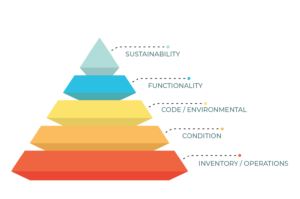Coming out of discussions and presentations from the APPA National Conference in Nashville that I recently attended, today’s post will be the third and final of the series within a series focusing on how to support your decision to divest/demolish buildings.
At the end of last week’s post I introduced the idea of taking a holistic view of the buildings where you feel you need to consider making the hard decision to divest/demolish a building and you expect to get resistance from your stakeholder community.
What exactly do we mean by a more holistic approach. As we said previously, FCI is a good place to start but it is often not where you want to end. There are many other data streams that you should consider when studying a building on the bubble. The graphic below presents our hierarchy of existing building data. We recommend that you consider each of the data streams in your analysis.

By going beyond condition, you can get a more complete understanding of the liabilities associated with the existing building. How does it meet your functional needs? Is it full of asbestos, how energy efficient is it? How many grandfathered code issues would you trip if you tried to renovate it? By gathering all of this additional data, you will be able to paint a more complete picture of what it would take to maintain the current building, recognizing that even if you did, you would still have “old bones” within the building.
If you are looking to downsize your portfolio, you also need to understand what your overall space needs are. Do you need the space within the building or can you demolish it and reallocate your Operations & Maintenance and Deferred Capital Renewal and Maintenance (DCRM) funding to the other buildings in your portfolio to your overall benefit.
If you are looking to replace the existing building with a new facility, we also recommend that you do a “features” comparison, wherein you provide the costs to “upgrade” the current facility to include (where feasible) the elements and features that you would get in a brand new school.
For example, if you have an old elementary school that does not have air conditioning, a Facility Condition Index (FCI) would not include money to install it as that would be considered an upgrade. However, if you build all new elementary schools with air conditioning, it makes sense to compare the new school with the current school when doing your analysis.
Where we have seen clients have the most success in making the tough decision to close an existing facility, the most successful program included crafting a story for stakeholders that took into account all of the varied issues about the existing facility to provide the most complete picture of why the decision is being made and why everyone will be better off on the other side.
As I said before, there will always be those that will resist no matter what. Unfortunately, we have not found a way to take all of the emotion out of the process. If you do find a way, please let us know.
This will wrap not only this mini-series, but also the post summarizing ideas and things I learned at the APPA National conference. I will be back next week with something new.




